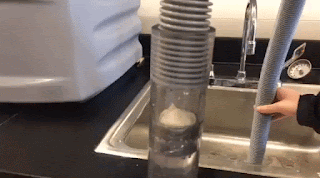Week 8
This week in lab, the group received their 3D printed heart valve prototypes. The prototypes are shown in figures 1 and 2. The prototype on the left was printed with an outer diameter of three inches and will be used for display during the final presentation. The prototype on the right was printed with an outer diameter of one inch. This one will be used for testing.
Figure 1: Top view of both heart valves side by side
Figure 2: Isometric view of both heart valves side by side
In addition to the group receiving the 3D printed heart valve prototypes, the group obtained a water pump to use for testing. Testing went relatively well. The heart valve works but still needs improvement. Testing is shown in figure 3 below.
Figure 3: A video clip from testing showing heart valves opening
The group believes problems could be arising due to the inaccuracy of the 3D printer. The hinges that allow the leaflets to open and close are not as smooth as designed. This causes the leaflets to experience friction and get caught on each other leaflet.
Another thing that could have caused the friction of the leaflets, was how the prototype was attached to the pump. The tube that the valve was placed in was not completely cylindrical, resulting in an uneven pressure being applied to the prototype. This allowed for one of the leaflets to open and close more easily than the other two.
Outside of lab, the group will continue to research ideal coatings for heart valves. These materials ideally will be able to be put inside of the body and will reduce the clicking sound made by heart valves.








